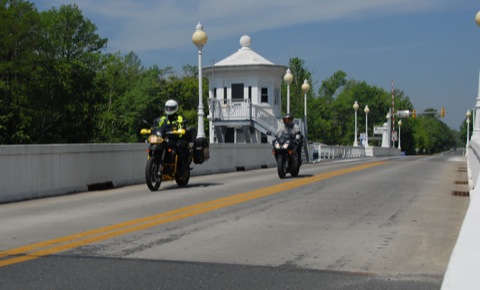Delaware, Maryland, and Virginia

Soaring 186 feet above the Chesapeake Bay, on its 4.3-mile namesake bridge, our motorcycles seem to have slipped the surly bonds of earth. Enormous ships glide silently below and seagulls follow our exhilarating descent onto Kent Island, MD. Another bridge crossing and we'll arrive on a rural and historic peninsula of land that's claimed by three states: Delaware, Maryland and Virginia. Nowadays this land is known by its acronym: Delmarva. And like our European ancestors, we're here to discover the essence of this place.
Seafaring Surroundings
Our adventure starts with a delectable lunch of cream of crab soup and Caesar salad, just a few of the appetizing offerings at Hemingway's Restaurant on Kent Island. Our table affords a picture window view of the Chesapeake Bay Bridge, disappearing into low hanging clouds on this early May afternoon. My wife Karen, my riding buddy Bruce Read, and I review the itinerary for the next week when we'll be touring the Delmarva Peninsula. Then we're off, Karen and I on the BMW F 800 GS and Bruce on his Honda Interceptor.

During America's fight for its independence, Delmarva was the breadbasket for the revolution. Gristmills, like the one in Wye Mills, MD, ground harvested grains into flower, which were then shipped to General Washington's Continental Army. The Old Wye Mill is the oldest working mill in Maryland and it welcomes visitors. A docent explains the flour-making process to us, while a gently flowing stream outside keeps the mill's waterwheel rotating in its timeless motion.
St. Michaels, MD, is a favorite Chesapeake Bay destination for many skippers of power boats and sailing vessels, as well as tourists arriving on four and two wheels. One of this historic town's most notable attractions is the Chesapeake Bay Maritime Museum's eighteen-acre waterfront campus. It features nine exhibit buildings and scenic vistas of the Miles River, replete with classic wooden fishing boats bobbing on dock moorings.
Motorcycle & Gear
BMW F 800 GS
Helmet: Shoei Hornet DS
Jacket: Olympia Viper Mesh Tech
Pants: Tour Master Decker Leather
Boots: Alpinestars
Gloves: Dainese
One of the museum's most interesting buildings is the Hooper Straight Lighthouse, constructed in the typical low squat style of lighthouses built on the Chesapeake Bay. The museum also boasts an extensive collection of sail, power, and rowboats. In fact, one of the larger buildings contains a restoration and maintenance facility for its extensive collection of wooden boats.
Dark clouds gather in the fading afternoon light. It's obviously time for us to remount and race against the oncoming rain, to our overnight destination. We follow a deserted backroad to the shores of the Tred Avon River, in Bellevue, MD, where we wait for the Oxford Bellevue Ferry as it chugs across the three-quarter-mile watery expanse. Heavy rain and dense fog envelope the landscape by the time we finally board, so we immediately seek shelter under a covered portion of the deck. A ferry of some sort or another has been operating in this location since the 1690s.

Arriving in Oxford, we don't linger to see the sights. As we push on to our lodgings in Cambridge, I can't help but wonder, Oxford? Cambridge? Did the ferry somehow land us in merry old England?
Islands in the Bay
The next morning we're eagerly anticipating more adventure and clearer skies, but we soon learn that it's the same song, second verse, with the weather. It's still blustery and rainy when we arrive in Whitehaven, MD, a small remnant of a town on the banks of the Wicomico River. In Colonial times, Whitehaven was a thriving port city, and its namesake ferry carried settlers, wagons, and livestock across the river, which was then bustling with shipping activity.
Winding roads lead through farms and fields, made all the greener by near constant spring rains. The ubiquitous chicken farms are apparent to both sight and smell, since the, uh, chicken byproduct is used to fertilize many of the surrounding fields.
